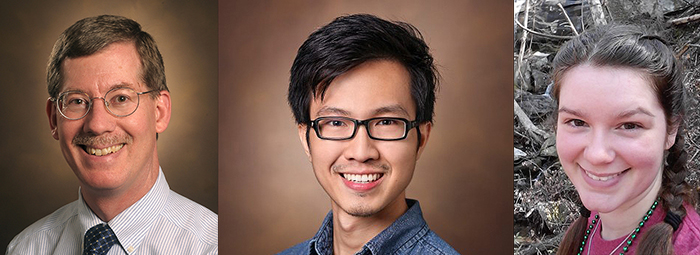By Emily Overway

Timothy Cover, professor of pathology, microbiology, and immunology, published an article in mSphere in late 2021 investigating infection by Helicobacter pylori, a bacterium that infects the stomach, potentially leading to gastric cancer. The research for the paper “Loss of Corpus-Specific Lipids in Helicobacter pylori-Induced Atrophic Gastritis” was led by co-first authors Aung Soe Lin and Jennifer Shuman and utilized imaging mass spectrometry to analyze changes in gastric lipid levels after infection with H. pylori. Lin, a recent graduate, and Shuman, a current graduate student, are both affiliated with the Microbe-Host Interactions graduate program.
We sat down with Shuman to learn more about the work.
What issue/problem does your research address?
The bacterium Helicobacter pylori infects the stomach of about half of the human population worldwide. Its colonization can be asymptomatic or can progress through a cascade of disease stages that lead to gastric cancer. The infection-induced molecular alterations that precede gastric cancer are not well understood, and these changes could potentially serve as biomarkers for premalignant disease development.
What was unique about your approach to the research?
The Mongolian gerbil is the animal model of choice for studying H. pylori-induced gastric disease. This is because Mongolian gerbils can spontaneously develop severe gastric disease, including gastric cancer, in response to infection. We took advantage of the Vanderbilt Imaging Mass Spectrometry Core for this work and analyzed gastric lipid alterations in the Mongolian gerbil model of infection and carcinogenesis.
What were your findings?
We found 36 gastric lipids that showed a change in abundance (they either increased or decreased) in response to infection with H. pylori or H. pylori-induced gastric disease.
The premalignant condition “atrophic gastritis” is characterized by loss of cell types that are specific to a region of the stomach known as the corpus. Cells in the corpus have specific jobs that help with digestion of food and help keep the stomach healthy. We identified 16 lipids present specifically in the corpus of uninfected or mildly diseased animals that were decreased or lost in severely diseased animals. The changes in these 16 lipids are examples of molecular alterations that indicate the development of severe, precancerous disease.
What do you hope will be achieved with the research results in the short and long terms?
In the short term, I hope these results will help fill a major gap in knowledge by describing what kinds of molecular alterations precede H. pylori-induced gastric cancer development, which will hopefully help identify problems in the clinic sooner. In the long term, I hope these results can help improve patient outcomes and decrease the need for costly procedures. For example, if we can identify a lipid biomarker that is increased or decreased in premalignant gastric disease and that can be accurately measured in the serum, we could decrease the need for costly and invasive gastric biopsies.
What are the societal/environmental/economic benefits of this research?
Gastric cancer is not usually detected at an early stage, and approximately 10,000 people in the U.S. die from the disease each year. This research could lead to methods for early detection of gastric cancer, improve patient outcomes, and decrease painful and costly procedures associated with severe gastric disease.
Where is this research taking you next? What will you personally be doing, or how will other researchers build on this work?
Having looked at changes in lipid levels for the current paper, the Cover lab will be partnering with the proteomics core to analyze molecular alterations in gastric proteins in response to H. pylori infection and infection-induced gastric disease.
Funding
This work was supported by the National Institutes of Health, the Department of Veterans Affairs, the Vanderbilt Digestive Diseases Research Center, and the Vanderbilt Ingram Cancer Center.